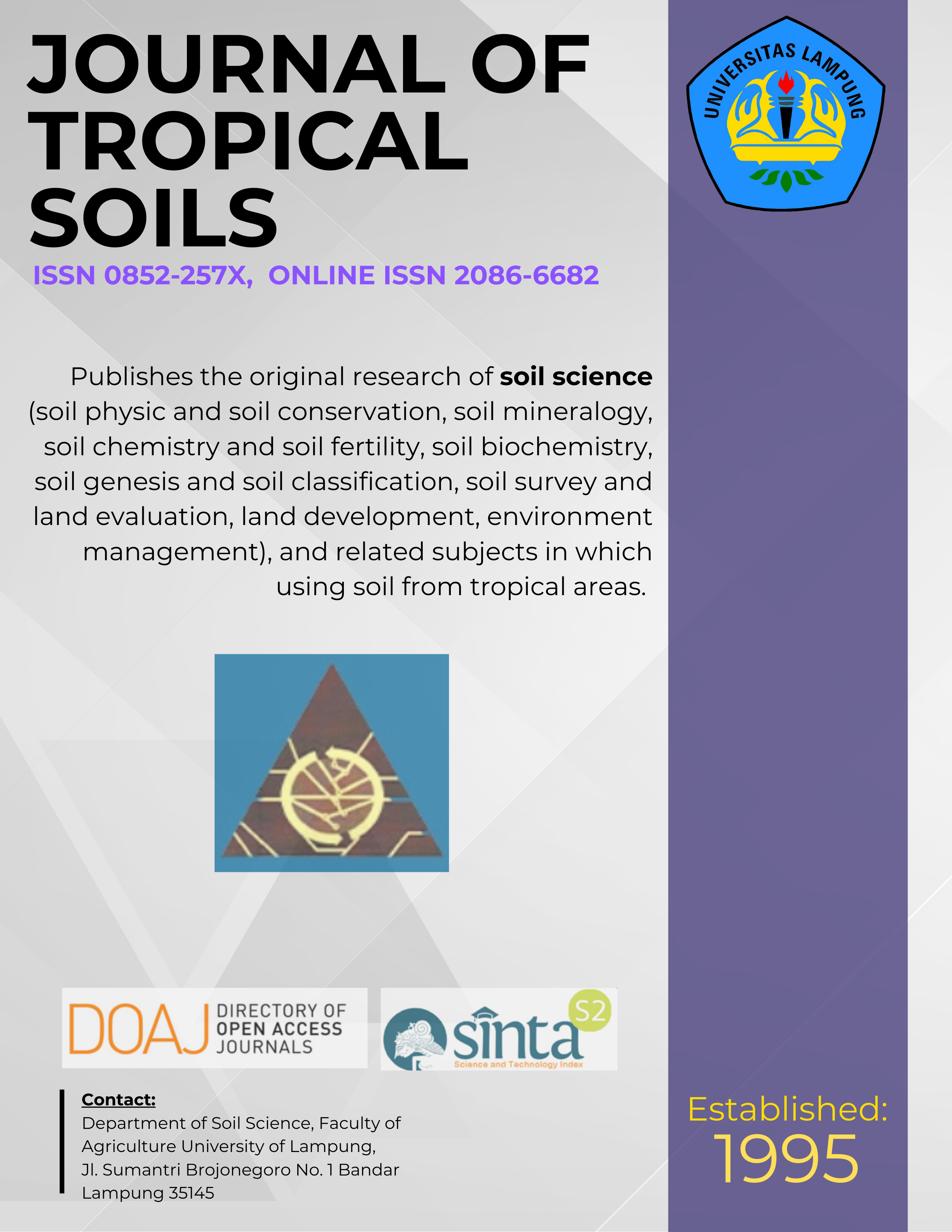Improvement of Soil Chemical Properties and Growth of Maize due to Biochar Application on Ultisol
Main Article Content
Abstract
Downloads
Article Details
License for Authors
Authors who publish with this journal agree to the following terms:
- Authors retain copyright and grant the journal right of first publication with the work simultaneously licensed under a Creative Commons Attribution License that allows others to share the work with an acknowledgement of the work's authorship and initial publication in this journal.
- Authors are able to enter into separate, additional contractual arrangements for the non-exclusive distribution of the journal's published version of the work (e.g., post it to an institutional repository or publish it in a book), with an acknowledgement of its initial publication in this journal.
- Authors are permitted and encouraged to post their work online (e.g., in institutional repositories or on their website) prior to and during the submission process, as it can lead to productive exchanges, as well as earlier and greater citation of published work (See The Effect of Open Access).
License for Regular Users
Other regular users who want to cite, distribute, remix, tweak, and build upon author’s works, even for commercial purposes, should acknowledge the work’s authorship and initial publication in this journal, licensed under a Creative Commons Attribution License.
References
Baronti S, G Alberti, GD Vedove, FD Gennaro, G Fellet, L Genesio, F Miglietta, A Peressotti, and FP Vaccari. 2010. The biochar option to improve plant yields: first result from some field and pot experiments in Italy. Ital J Agron 5: 3-11.
Deenik JL, AT McClellan and G Uehara. 2009. Biochar volatile matter content effects on plant growth and nitrogen transformations in a tropical soil. Western Nutrient Management Conference. Vol 8. Salt Lake City, UT.
Elad Y, E Cytryn, YM Harel, B Lew and ER Geabber. 2011. The biochar effect: plant resistence to biotic stresses. Phytopathol Mediterr 50: 335-349.
Ferizal M. 2011. Arang hayati (Biochar) sebagai bahan pembenah tanah. Balai Pengkajian Teknologi Pertanian Aceh. Edisi Khusus Penas XIII, 22 Juni 2011. (in Indonesian).
Glaser B, J Lehmann and W Zech. 2002. Ameliorating physical and chemical properties of highly weathered soils in the tropics with charcoal – a review. Biol Fertil Soils 35: 219-230.
Graber ER, YM Harel, M Kolton, E Cytryn, A Silber, DR David, L Tsechansky, M Borenshtein and Y Elad. 2010. Biochar impact on development and productivity of pepper and tomato grown in fertigated soilless media. Plant Soil 337: 481-496.
Hunt J, M Du Ponte, D Sato and A Kawabata. 2010. The basic of biochar: A natural soil amandement. Soil and Crop Management. College of Tropical Agriculture and Human Resources. University of Hawai’i Manoa.
Kaya E. 2009. Ketersediaan fosfat, serapan fosfat, dan hasil tanaman jagung (Zea mays L.) akibat pemberian bokashi ela sagu dengan pupuk fosfat pada Ultisols. J Ilmu Tanah Lingk 9: 30-36. (in Indonesian).
Lehmann J and S Joseph. 2009. Biochar Environmental management. Earthscan. London. 416p.
Lehmann J, JP Da Silva Jr, C Steiner, T Nehls, W Zech and B Glaser. 2003. Nutrient availability and leaching in an archaeological Anthrosol and a Ferralsol of the Central Amazon basin: fertilizer, manure and charcoal amendments. Plant Soil 249: 343-357.
Nigussie A, E Kissi, M Misganaw and G Ambaw. 2012. Effect of biochar application on soil properties and nutrient uptake of lettuces (Lactuca sativa) grown in chromium polluted soils. Am-Eur J Agric Environ Sci 12: 369-376.
Noguera D, M Rondon, KM Laossi, V Hoyos, P Lavelle, MHCD Carvalho and S Barot. 2010. Contrasted effect of biochar and earthworms on rice growth and resource allocation in different soils. Soil Biol Biochem 42: 1017-1027.
Nurida NL, Ai Dariah and A Rachman. 2009. Kualitas limbah pertanian sebagai bahan baku pembenah tanah berupa biochar untuk rehabilitasi lahan. Balai Penelitian Tanah. Bogor. (in Indonesian).
Prasetyo BH and DA Suriadikarta. 2006. Karakteristik, potensi, dan teknologi pengelolaan tanah ultisol untuk pengembangan pertanian lahan kering di Indonesia. J Litbang Pertanian 25: 39-47.
Rondon MA, J Lehmann, J Ramirez and M Hurtado. 2007. Biological nitrogen fixation by common beans (Phaseolus vulgaris L.) increases with bi0-char additions. Biol Fertil Soils 43: 699-708.
Santi LP and DH Goenadi. 2010. Pemanfaatan biochar sebagai pembawa mikroba untuk pemantap agregat tanah Ultisol dari Taman Bogo-Lampung. Menara Perkebunan 78: 52-60. (in Indonesian).
Smith JL, HP Collins and VL Bailey. 2010. The effect of young biochar on soil respiration. Soil Biol Biochem 42: 2345-2347.
Soemeinaboedhy IN and RS Tejowulan. 2007. Pemanfaatan berbagai macam arang sebagai sumber unsur hara P dan K serta sebagai pembenah tanah. Agroteksos 17: 114-122. (in Indonesian).
Sulaeman, Suparto and Eviati. 2005. Petunjuk Teknis Analisis Kimia Tanah, Tanaman, Air, dan Pupuk. Balai Penelitian Tanah. Bogor. 136 hlm. (in Indonesian).
Yamato M, Y Okimori, IF Wibowo, S Anshori and M Ogawa. 2006. Effects of the application of charred bark of acacia mangium on the yield maize, cowpea and peanut, and soil chemical properties in South Sumatra, Indonesia. Soil Sci Plant Nutr 52: 489-495.
Yuwono NW. 2009. Membangun kesuburan tanah di lahan marginal. J Ilmu Tanah Lingk 9: 137-141. (in Indonesian).
Zhang A, Y Liu, G Pan, Q Hussain, L Li, J Zheng and X Zhang. 2012. Effect of biochar amendement on maize yield and greenhouse gas emissions from a soil organic carbon poor calcareous loamy soil from central china plain. Plant Soil 351: 263-275.

